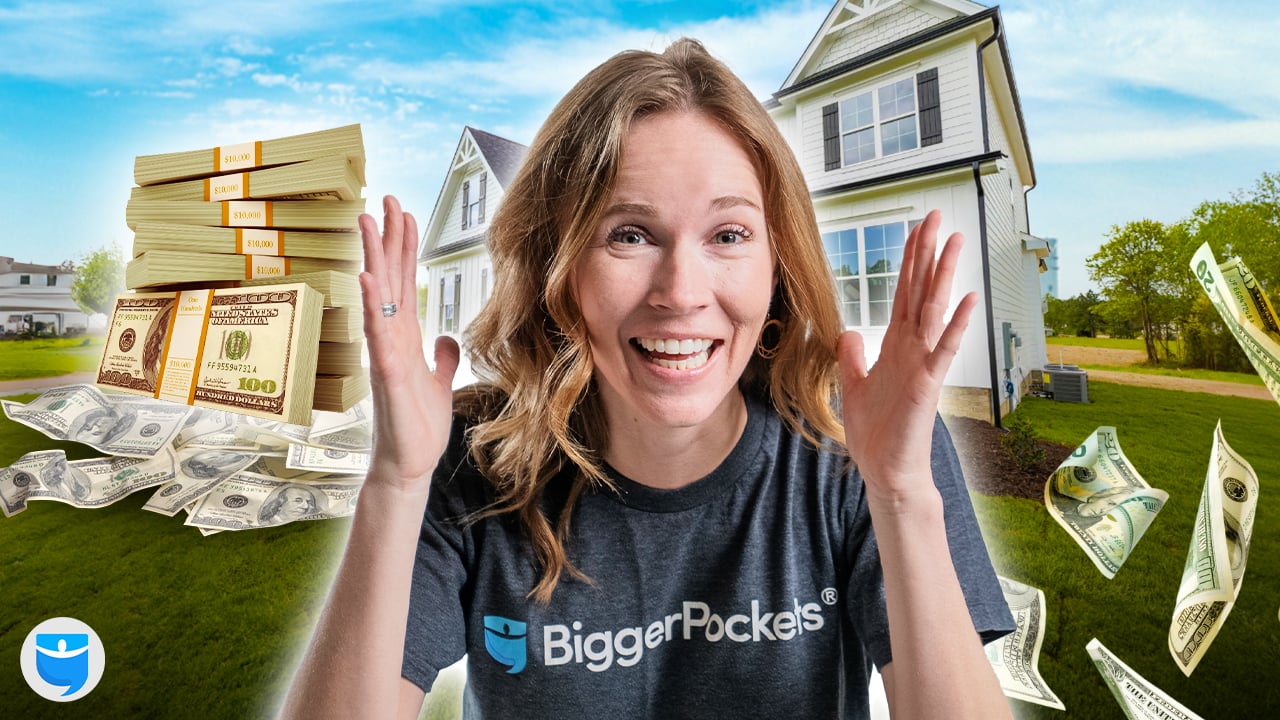We know mortgage rates will fall this year, but how long will we have to wait? Will they get down to the fives or stay in the six-percent range? And even if the Fed lowers the federal funds rate, will this significantly impact mortgage rates? We brought on three elite lenders to get their takes on when rates will drop, how low they could go, and why waiting for lower rates is a riskier decision than you think.
Caeli Ridge joins us again as our go-to investor-lender combo, and Krystle and Kenny Simpson, San Diego-based lenders, are on the show to give their viewpoints from the small investor and large commercial lens. Plus, these lenders are about to share the info on some investor loans that you may have NEVER known about—loans that other investors are taking advantage of TODAY to get deals done, even with high interest rates.
Speaking of high interest rates, our lenders show mathematical proof that rates are NOT the defining factor of your real estate deal and how waiting for a half-percentage drop could cost you more than you think. Plus, the commercial real estate “bloodbath” coming for one certain sector unless local governments step in.
Dave:
Hey everyone. Welcome to On the Market. I’m your host Dave Meyer. And today, we are talking about loans, loans, and more loans. I know mortgage rates and the cost of debt is on everyone’s mind. So we are bringing together three excellent lenders from across the spectrum of different types of loans to talk about what they’re seeing in the market today, and they’re going to share their knowledge about where they think rates are going, and I think really crucially about what loan products are working right now in today’s environment.
Our first guest you might recognize, she has been on On the Market a couple of times. Her name is Caeli Ridge. She’s the president and CEO of Ridge Lending Group. She’s a real estate investor and has been doing this for a very long time. And we also have two new panelists joining us today. Kenny Simpson, who is a loan officer, works mostly in residential with investors out of San Diego, and his wife Krystle Moore, who is a commercial lender and has a huge depth of experience in commercial loans. And we’re going to learn a lot about everything that these three lenders are doing today.
So without further ado, let’s bring on our panel to talk about the state of lending in January 2024. Caeli, welcome back to the show. It’s great to have you back. For anyone who didn’t listen to your previous appearances, can you just remind everyone where you’re located and what you do as a lender?
Caeli:
Absolutely. Hi Dave. Thank you for having me. It’s great to be here. Caeli Ridge, Ridge Lending. We are a full service lender that focuses not exclusively, but primarily on real estate investors, residential and commercial, nationwide. Well, we’re in 48 states. We’re not in New York or North Dakota, but otherwise, we’ve got a nice broad footprint. We really put a emphasis on education, which I personally believe is missing in real estate investing from a lending perspective. It’s not dear Google stuff as I like to say. Very broad, diverse city in our loan products. I like to call it our lending menu. Lots and lots of programs in there. Maybe we’ll get to some of that today.
And I think, otherwise, I would just share that I am a fellow real estate investor, so I do have a unique lens in all of this, being able to see it from both perspectives, an investor and a lender focusing on investors that I hope adds some credibility.
Dave:
Great. Thank you. It’s a pleasure to have you back. Kenny and Krystle, it’s excellent to have you here for the first time. Krystal, let’s start with you. Could you introduce yourself to our audience?
Krystle:
Yes, absolutely. And thanks for having me here as well. I think one of the things about BiggerPockets is it brings together these people with these unique backgrounds, just like you Caeli. My background is very similar. My company is Pacific Shore Capital. I’m a broker. I’ve been a broker for about 21 years now. The majority of our focus has been in California. We do do lending in other states. Of course, I have a lot of California people who refuse to invest in their home state, so we go out of state for those as well.
And I, like Caeli, am also a apartment owner and an investor. We also previously owned a property management company that managed about 1500 units here in San Diego. I’m very happy to say that I sold that in late 2017. And I am back to just 100% focusing on lending and investing in our own portfolio.
Dave:
Great. And what about you, Kenny?
Kenny:
So, I’ll just jump on the bandwagon with Krystle. So everything she said, but I do one to four residential. So because Krystle, when we got together, we’ve been together about 15 years, I had a lot of opportunity to work with real estate investors. So I had to get really good with tax returns and scenarios and self-employed and where to place loans. So it was kind of like, hey, this isn’t an option, you need to figure these out. And so I became an expert quickly. And obviously with our background in real estate investing, managing and all that, we are a wealth of knowledge for clients.
And I really truly, like you said Caeli, I believe in education. And people just really can’t get that out there. So working with a lender that has our background, just like you’d probably agree with Caeli, is really important for investors and it helps them out a lot. So making moves and closing deals.
Dave:
And Kenny and Krystle, just to be clear, you are sharing a room and studio right now because you are married, right?
Kenny:
Yeah. And just if you want to make it easier, everybody calls us K and K. So it’s just-
Dave:
Okay.
Kenny:
… literally, even on emails, everybody’s just like, “It’s too long. We’re just going to go, ‘Hey, K and K. Hi K and K.’” So K and K is fine.
Dave:
All right. Well, let’s jump right into the meat of our conversation. I know everyone in our audience wants to know about interest rates and what’s going on. So Caeli, let’s start with you. Can you just give us some context, where on the mortgage rate rollercoaster ride are we right now and how is it impacting volume and activity in your firm?
Caeli:
I’ll start with the last part first. I think volume tends to be, for lenders that focus on investors, a little bit more steady than those that are exclusively owner occupied where people live, because investors are always going to be investing regardless of the interest rate. So I think that we’re a little insulated that way. I would say, where rates are now, we saw a little bit of a reprieve at the end of the year. I’m sure everybody saw those headlines, et cetera. They’re ticking back up just a little bit. But I think, overall, I’m interested to hear what Kenny and Krystle say, I think we’re on the downward trajectory.
The last three out of the four economic reports that we received came in a little too hot. You’ve got your CPI, consumer price index, the jobs report, retail sales, all of those came in high, and that’s not good for rates. It was only the PCE that gave a little relief, the personal consumption expenditure for those that aren’t familiar with those acronyms. But the good news is, is that that’s the one that the Feds follow most closely, is that PCE. So I think we’re on the down slant. I don’t know that I agree with some of the announcements that are saying March is when we’re going to see the first Fed fund rate reduction, which by the way is not the same as our 30-year fixed, just to put that out there. The Fed fund rate is an indices but not necessarily how it would tie to the 30-year fixed mortgage rates. I’m going to predict June for the first Fed cut. We’ll see.
Dave:
I love this Caeli. Usually I have to milk predictions out of people and you’re just giving them right away. So I like that.
Caeli:
Get it out of the way.
Dave:
Yeah, thank you. I appreciate it. Kenny, what about you? Are you seeing something similar? And what are your feelings personally about the direction of rates?
Kenny:
Yeah. So I’m a data nerd. I love setting data. And just like Caeli, to back what you’re saying, the data is mixed. And I tell people this isn’t a straight down to the bottom. This is a little bumpy ride. It could be a little bit of a roller coaster. But clearly, look, we started this year off with a different Fed than last year, not hawkish. We knew we weren’t going to get the hikes. We knew we weren’t going to have higher rates. We knew we weren’t going to get punished. I think we are. Maybe we ran up the mountain, I kind of said, and now we’re slowly coming back down.
So I predict rates will definitely start coming back down probably later more in the year. Look, if we’re lucky, the conventional rate would have a five in front of it, so keep our fingers and toes crossed. But I do agree with you, Caeli, that probably a May, June cut is inevitable. I think also he wants to get ahead of it and not wait too long until there’s too much pain because then it’s too late, which they love to do. So I think it’s just going to be slow and steady, but I think we did get a big rate reprieve now where conventional rates had it first and then non-QM just caught up in the last couple of weeks. And some of the private banks, we saw them too. They were waiting, I think, until the beginning of the year, a little bit hesitant.
And so now, we’re just cruising, and I think we’re going to need more data to come in our favor to see rates tick down even more.
Caeli:
They always go down slower than they go up, unfortunately.
Dave:
Yeah. I think especially in this case.
Kenny:
Yes. I mean, hey, a six and a half, whatever, is better than eight. I think we can all agree. So I’ll take it.
Dave:
Yeah. And I want to reiterate something that Caeli said earlier, that the Fed, although they influence mortgage rates, do not dictate mortgage rates. We talk about this a lot. But they are much more closely tied to bond yields. And while bond investors look to the Fed when they make their decisions, they look to a lot of other things as well, like risks, recession risk, the price of equities. There’s tons of other things that go into this. And so it is not a one-to-one relationship to Fed rate cuts to lower mortgage rates.
The other thing is that mortgage markets, bond markets work in a different way than you might think. And a lot of what’s happening and the rate reprieve that we’ve seen in the last three or four months or so are already factoring in some future Fed cuts. They’re not waiting around saying like, oh okay, they’re going to cut rates in the future and then all of a sudden they’re going to change their activity. They’re anticipating rate cuts and adjusting their investing behavior already. So a lot of the benefit of three potential rate cuts is already being felt by the market. So I just want to make that clear for everyone.
I do want to hear one more final market prediction from Krystle’s perspective about commercial real estate and what we can expect next year. But before we do that, here is a word from our sponsors.
Now Krystle, the commercial market is a bit different than the residential market. So where are rates, and are you as cautiously optimistic about the direction for the next year?
Krystle:
I am. In terms of the commercial market, I know that it’s very hyper-local too. It really depends on what market you’re in. Every market is slightly different. So for example, we’re in San Diego. If you’re in any of the major cities in California, for the most part, there’s still some competitive loan options out there. But cap rates really haven’t dropped enough to meet where we are with interest rates. So while I am still seeing people being active, I’m seeing a lot more loan assumptions, people paying with cash, people borrowing against their stock portfolio to wait until rates come down.
Even I’m having a lot of conversations for people who have refis coming up in 2024. And the conversations we’re having is, maybe you wait and let it adjust up one time and then you give yourself another six months to a year depending on what your adjustment caps are, to wait and see when rates are going to be better. Because to your point, a lot of the move, I feel, my prediction is that a lot of the move in treasuries has happened already. So we got that 100 basis point dip. To expect that we’re going to dip quickly another 100 basis points is, it’s really not in the data.
So if you look at the last three cycles when the Fed decided to pivot, the 10-year treasury dropped about 150 basis points in the 12 months following. So I really think we have another 50 to 60 basis points from where we’re at today throughout this entire year. So we dropped from October to December 100 basis points. It’s not going to happen that way this time. So I’m really guiding people to maybe wait or to lock in on the shortest prepay you can possibly get so that way you can be ready to take advantage of the opportunities when they come because they will come. We may have to survive till ’25, but the lower rates will come. That is my prediction.
Caeli:
Can I interject? That’s really smart, Krystle, for the right individual in the right circumstances, letting that rate just go ahead and adjust if your adjustable is coming due and looking at having your expert that you deal with and seeing if that’s the appropriate move and letting it adjust once before you look to refinance and try and futuristically see how that’s going to impact you. That’s really a smart strategy.
Kenny:
Yeah, especially because, on commercial, as we maybe all know here, the audiences know, you’re most likely locking in on a prepay. So once you lock the loan, if even it’s a five or a three-year, seven, you’re locked in and you’re not going to want to deal with that. Even on investors now, when I’m doing DSCR loans or non-QM, I’m highly recommending a one year prepay not three because I think they’re going to regret that. So if anybody’s listening, like prepays do matter because you might regret that later. And that’s why if you can allow it to adjust and you can take that and you can make it work with cashflow and everything, I think we all agree here that might be a smart move. But Krystle also is going to jump in this.
The other issue you have is, we have Fannie, Freddie, the non-QM that’s very liquid and moving and fluid. Your banks, a lot of them aren’t even lending too because of the… You might want to discuss a little bit into that. I don’t know if you guys want to get into that, Dave, but there is that obstacle too.
Dave:
Before we jump into that, that’s a great point. I just want to clarify two things for our audience to make sure everyone’s following along. One is that when you look at non-conventional, a lot of commercial loans, there’s a prepayment penalty. And so refinancing doesn’t come without its negative consequences. And so the discussion here is that, rather than refinancing preemptively and incurring some of those fees, you may just say, “You know what? ’24 is going to be a tough year. Let’s let that adjustable rate go up this next year. Because then in a year, maybe when we refi, yes, we’ll pay those prepayment penalties or we’ll have to pay some refinancing fees, but at least at that point, we might be locking in a lower rate.” So that was number one.
The second thing is that a DSCR loan, just to clear up, that acronym sets for a debt service coverage ratio loan. It’s basically a residential loan that’s underwritten like a commercial loan. So rather than using a person’s individual credit and credit worthiness, it’s underwritten on the strength of the deal, which is how commercial loans are underwritten as well. So with that, let’s get back to what we were just talking about. And Krystle, I am curious about what kind of activity is going on in commercial. Because unlike what Caeli said when she said it’s a little more stable for investors, I think that’s probably true a lot on the residential side, residential investing.
But at least from what I hear, volume in terms of new purchases for commercial multifamily is down, and is that what you’re seeing?
Krystle:
Absolutely, yes. So volume is down and it’s down pretty significantly. So if we’re talking about the brokerage community, in 2023, they had a pretty good year most of the year. And then about Q4, it started dropping off some. It’s just harder to make deals pencil. And there are transactions happening every day, but they’re at a much lower level. Because I have CoStar, so I look at transaction volume. And it was down 50% in 2022 and then it went down another 35% in 2023. So transaction volume has come way down. And I’m looking in my core market. Other markets may be different.
Banks are coming in and out of the market. So we have Fannie and Freddie financing just like the rest of the country, but most of our borrowers tend to be more what we call mom and pop investors. They have smaller buildings and they’re not really comfortable with the yield maintenance prepay. Also, Fannie and Freddie have a lot more requirements in terms of looking at the loans, like the property condition reports and things like that that a small local bank or even a large regional bank wouldn’t necessarily have. So they try to stick to bank financing and avoid the agency debt if at all possible.
Dave:
Kenny, in your business, who are the type of investors or clients, I should say maybe they’re not investors, the clients that are still transacting and who are the most eager to get into this market?
Kenny:
We’re in San Diego. So obviously everybody knows about house hacking, hopefully. I feel like San Diego is one of the best places to house hack. We have a lot of military here, so you got the VA loan. A lot of people here are like, “Why buy a home? [inaudible 00:16:23] buy a two to four.” Obviously Fannie and Freddie made our day with 5% down on two to four, so that was a party. Because with FHA, you had to pass the self-sufficiency test, which means the building standing by itself, 75% of market rent has to be more than your PITIMI, which is hard to do in a place like San Diego.
So the house hackers are here. They’re loving it, and it’s helping. A lot of people I work with too are home flippers, real estate investors and stuff. So they’re getting fix and flip loans, they’re getting private money loans. So I actually do a lot of refis to get them out of the 9-10%. So that is very active. And obviously I work with the first time home buyers, stuff like that. Those are obviously always moving. But as far as investors, I would say the flippers and the house hackers and people like that are really active.
And I don’t think, because interest rates are a little bit too high, I’m not seeing too many people like prior just jumping in the market that are just normal investors. I think it’s a little bit too high. But when rates come down, I think they’ll be swinging back in the market to start buying stuff. It makes more sense.
Caeli:
Agreed. I love the house hack. It’s such a great way, especially for newer investors to get involved in real estate. I couldn’t agree more. The house hack is amazing. And Fannie, Freddie really put us on the map for being able to offer something that is probably accessible to a lot more than it was before.
Krystle:
And just to chime in here for one minute, because we do share a lot of the same clients that are flippers and things. When we had that little rate dip in December, a lot of our house flippers ran out and bought five, six homes that week. So you can see every time we get a rate dip… And we know it’s not going to be a straight line down. But every time you get that little dip in rates, it gives the flippers confidence that the housing market is going to be strong and there’s going to be a demand out there for them to continue doing what they do. So I think even if we see rates tick down half a point, we’re going to start to see more activity kick up because it just gives people more confidence, especially investors.
Dave:
Yeah, that’s great to hear. It makes you think that there’s all this pent-up demand sitting on the sidelines. Because back-
Krystle:
Feels that way.
Dave:
… when I first started doing this, a 25 basis point change in mortgage rates would change absolutely nothing. No one would even notice it. And now, everyone’s just frothing at the mouth when there’s a little bit of a dip. And so it makes you wonder if we do get rates in the low sixes or perhaps even into the high fives, what type of resurgence in demand there might be.
Caeli:
Dave, since we’re talking about rates, I always want to take a minute and make sure that we educate, communicate, that if you’re not doing the math… I know everybody has got that focal point on the interest rate, but the rate may be so much less significant than what psychologically an investor believes it to be. It’s, I think, largely dependent on the loan size. And that actually played into. I wanted to say, going backwards to Krystle’s comments and Kenny’s comments about prepayment penalty, you got to do the math. You have to understand what would be the prepayment penalty dollar wise right now. Do you have the equity in which you can afford that? What is the difference between six and a half today and six and a quarter, 6% in six months? What opportunities would you be missing out on?
If you’re not running the numbers and all you’re doing is waiting for the headline to say that interest rates have hit this mark, then you’re really, I think, you’re at a disadvantage and you will miss out on, I think, real tangible opportunity.
Krystle:
Caeli, I love that point that you just made. One of the things that we’ve done over the last year and a half with our clients is they’ve come in the office and we’ve sat down and ran best, middle and worst case scenarios. What if rents drop 10%? What if rates go to eight? What if rates come down to six? What if they go to five and a half? So it gives you a high level overview of what things are looking like and what you can live with. Because the one thing I always say, and you said something similar earlier, is that when it comes to getting your financing, you really have to compromise. You’re not going to get 100% of what you want, but you need to figure out what you can live with.
And the beautiful part about real estate is it all comes down to the numbers. So it’s very simple. If you just do the numbers, the answer will come to you.
Caeli:
And the math won’t lie. Right? The math will not lie. So exactly. Yeah, I agree 100%.
Dave:
That’s a very good point. I think people are slowly, hopefully, getting over the whiplash of these rising rates. I do think that it was, like you said, somewhat psychological, and this ending of what is probably going to be a once in a lifetime era where rates, we were seeing conventional rates in the threes. And people were sad that that is no longer around. But the average rate of the last 50 years and a 30-year fixed rate mortgage is about 6%. And so we are returning to what is the long-term average. And personally, I think actually, for the long-term health of the housing market, something closer in the five or sixes is probably better for more sustainable and regular growth. But maybe that’s just me.
Caeli:
Dave, we’re talking about those great rates. And I know, like Kenny and Krystle, that conversation is being had multiple times in any given day. They don’t want to mess with their 3% or their 4% or their 2.5%, whatever. Statistically speaking though, the reality of it is, the percentage of people, even without those rates, prior to, and with those rates, now the percentage of people that are going to keep those loans from day one and make 360 payments later to pay it off is this much. So I get it. Psychological stuff going on there. And I know it’s going to be hard for people to get over. But the truth of the matter is, is that most of those loans will refinance or pay off at some point before 30 years is up.
Krystle:
Well before.
Caeli:
Yeah.
Dave:
Well, there’s a reason why mortgage rates are so closely correlated to the 10-year treasury. It’s because mortgages are typically taken out even though for 30 years, they last closer to 10 years. If they lasted 30 years, you would see a much stronger correlation between the 30-year treasury and mortgage rates. So that’s a very good point.
Caeli:
Good point.
Dave:
Now Caeli, you alluded to this earlier that you offer a lot of different loan products. Has the mix of loan products or are there particular types of loans that have been of interest to real estate investors of late?
Caeli:
I would say the second lien HELOCs are doing pretty well because for just the very reason that we just spoke about, people are really hesitant to give up those 3 and 4% interest rates. So the second lien HELOCs for investment properties has been pretty popular. My favorite personal product is the first lien HELOC. It’s called an all-in-one. It’s kind of an arbitrage. If you’ve heard of velocity banking or infinity banking, conceptually that’s what we’re talking about here. Those have done very, very well over the last couple of years in this higher rate environment I feel like for the right individuals, and that’s the all-in-one. It’s been phenomenal.
And in fact, there’s a simulator that we can use to compare a 3% interest rate against an adjustable 8% HELOC, first lien HELOC. And the math won’t lie. As we just said, it’s kicking the crap out of it. It’s absolutely destroying some of those lower interest rates because it’s about velocity of money and how quickly you’re able to pay it off. Because remember, the mortgages we’re talking about here, most traditionally, the amortization over 30 years and the amount of interest that goes into that, yes, we get very low payments, which is fantastic. We’re one of the only countries in the world that allows their citizens to have this.
But has anyone looked at the Truth in Lending statement before and seen what you’re borrowing versus what you’re going to end up paying an interest? It’s a lot. So anyway. To answer that was probably a lengthy answer, Dave, but second lien HELOCs and the all-in-one first lien HELOC are the two, I think, have really been profound winners in the last couple of years.
Dave:
Can you explain a little bit more about what that means and how it’s even feasible that a loan product with an 8% interest rate would beat something with a lower interest rate?
Caeli:
Yes. So one of the easy examples that I give that I think people can wrap their heads around quickly, because I think we’re kind of preconditioned to only understand that closed ended amortized product, and this is 180 degree different from that. But take a 15-year fixed and a 30-year fixed. Okay? Both of these mortgages start at 400,000 as the principal balance. The 15-year fixed locks at 7% and the 30-year fixed locks at 4%. Without exception, unless they know the math of amortization, everybody’s going to run to that 4% interest rate. But when you do the math, you’re going to realize you will pay $40,000 more on the 30-year 4% than you would the 15 at 7%.
So I feel like that’s the example that I can give where people initially can really understand its velocity and time in which you’re going to have the mortgage. An open-ended line of credit, you’re able to utilize your depository dollars. Gross rents, net income, driving balance is down significantly. And there’s a compound effect of saved interest because interest is calculated daily based on the balance and that month’s rate. So there’s a snowball that goes into daily and then monthly residual incomes that are left over. So it’s a really, really powerful tool that I think investors especially can utilize and have huge success with.
Dave:
Wow. That’s super interesting. And is the application process any different for it?
Caeli:
It sucks. The application process sucks. I’m not going to mince words.
Dave:
All right. I like that.
Caeli:
So, of all of the underwriting and processing that we do… Everybody, if you’ve been doing this long enough, you know that you used to be able to fog a mirror, right? You’d have a pulse and you could get a loan. Well, post ’08, ’09, that all changed and it’s become a lot more cumbersome to go through the gauntlet of prequel and underwrite, et cetera. The all-in-one takes that to another level. So I always want to set the expectation for our clients that are interested in this, be prepared for a little bit of brain damage. It’s well worth it, but the underwrite is a little bit more intense.
Dave:
So now, we’re going to move to Kenny and Krystle and hear the advice that they’re giving their investor clients and what products they’re using. But first, we’re going to take a quick break.
Kenny, are you seeing similar things? Or what are you recommending to clients these days?
Kenny:
That is a good program. I actually don’t really do much of that. But I think people that focus on it do. It does wonders for people. I think for me, in a lot of my business, it’s pretty mixed. But since I work with a lot of real estate investors, I think a lot of people too. Because Fannie’s gone so high and maybe DSCR, a lot of people just said, “You know what? Let’s just do a DSCR if we can ever, sending a full doc loan in because it’s not much different.” So what we’re seeing is, people are like, “I’m going to refi anyway, so let’s maybe do a DSCR, interest only.”
And when you look at the interest only, it’s almost like dropping the rate down a point if you’re paying principal and interest. So we’re seeing a lot of that. And fix and flip. So obviously there’s a traditional. But I think the big pickup that I’ve seen is non-QM business, because a lot of real estate investors just don’t want to do the full doc thing. I think it’s more like, it’s not much benefit in rate and let’s just deal with this at another time. We know we can refi all this up. So I think people are just kicking the can down the road saying, “I know I’m going to have a big refi year in ’25 or something.” And I think we all can agree on that. It’s one of those years. And they just want to make it simple and easy.
Dave:
Got it. And can you just explain to everyone what a non-QM loan is?
Kenny:
Yeah. Non-QM is actually non-qualified mortgage. So there’s Fannie, Freddie and there’s Ginnie, which is pretty much backed by the government, let’s just say. So there’s a certain amount of guidelines that you have to qualify for. And then non-QM is basically, let’s just say this has a different sided guidelines. It’s kind of an outlier. So those are primarily picked up and sold on the secondary market, not that you can’t sell Fannie, Freddie or that. So back in the day, I don’t know if you say, when we had the loans where we had, most of the loans were sold off to in the secondary market. I just think we didn’t have them because when we had the crash, we was all Fannie, Freddie, Ginnie, because the government put our noose around our neck, had it tight. And so this has kind of opened up.
So I think of it as if you’re self-employed or you have issues with taxes or you want to go DSCR and things like that where you want to be a little more flexible on the guidelines, it’s the simple way to say it, that’s where you’re going to be able to go. Those type of loans. Big banks and stuff are really not doing them. They just stick to the more cookie cutter conventional type stuff, which is Fannie, Freddie, Ginnie.
Dave:
Now Krystle, you told us a little bit about how you’re advising your clients right now. But since you’re here, I can’t resist asking you about commercial real estate in general. It’s like every other day, there’s a headline about how there’s going to be a finance led or a funding led commercial real estate crash. What do you make of that headline and where do you see the whole commercial market heading this year?
Krystle:
Well, the way I’m interpreting it is that, for the most part, there’s always those outlier lenders that are usually much smaller and don’t have the same auditing requirements as the larger banks that may come in and be more competitive here and there. But overall, what I’m seeing is that our commercial lenders are keeping their spreads pretty thick, thicker than usual, because there’s a storm of things, like a perfect storm. It’s like they’ve got all these 3% loans on their books that need to start paying off. They are not sure about these looming reserve requirements that are going to come for them. So they’re trying to basically beef up their balance sheet as much as humanly possible so that way they’re in compliance whenever that gets decided on.
And then there is this looming office debt that everyone is saying there’s going to be a lot of debt that’s not going to be able to be paid off. A lot of people are going to be underwater. We’re hearing stories all day long about buildings that are 40, 60, 80% vacant and people are not returning back to the office. So that’s really creating this uncertainty. And banks don’t like uncertainty. They just don’t. And when that happens, they pull back. So what I’m seeing with my lenders is that if you want to come with a straightforward multifamily deal even, let’s say, they’re really looking for stronger borrowers, better located properties, more conservative LTVs, and they don’t even care as much about the big fish.
So even the guy who has 10 million in liquid assets is getting a little better deal, but really not that much compared to his strength. Banks are more about staying safe right now than making exceptions for strong borrowers or well located properties. So that’s what I’m seeing right now in the lending space for conventional. I mean, we’re still doing bridge and some other things like that. But if you want to go get the lowest fixed rate loan, it’s tough out there. This week, I had a lender come in the market this week. Two weeks ago, they weren’t even here.
And then they’ll go out of the market after they get their bellies full, get a handful of loans, and they’ll step out and somebody else will step in. So that’s what I’m seeing right now, is just a lot of shifting of lenders and who’s competitive.
Caeli:
I mean, just to interject there, doesn’t that mean that we are on the precipice of some huge opportunities on the commercial space, right? I mean, I’m seeing the same headlines you guys are. I expect though that I think that there’s going to be some real… For the ones that are going to be the most affected, like the office space, like you said, Krystle.
Krystle:
Yes.
Caeli:
And this is your wheelhouse. So I’d be interested to hear what you have to say about it. But converting some of those commercial buildings, their expectations are they’re going to get them for cents on the dollar and converting them into something that would be relevant for storefront and the services that still require that. Right? Office stuff is, nobody is really… I’m in class A office space right now and it’s about 30% occupied, to your point.
Dave:
Wow.
Caeli:
So that’s going to be, I think, what we can expect in the future. And those that are prepared and ready for it, I think, are going to take advantage of it.
Krystle:
I completely agree with you. Now, I love the narrative of converting office to residential. I just think actually getting that done is a lot more complicated. So once again, I think it’s going to be reserved for the big boys who have a lot of capital that can go through all the hoops and all of the things. Because if you think about some of these offices, they don’t have the kind of electrical and plumbing and things that you need, the size of the windows. I mean, you can get into the weeds with all of this stuff, but I love the idea. And I think that cities and counties are going to have to figure out how to make it work a little easier because there’s just going to be a bloodbath for office. It’s coming.
Caeli:
What about spa services or other services? So conversion for housing, great. But the other thing I’m hearing is things like day spas or things in which you need to be there for the service. Hair, nails. I mean, maybe this is just for the ladies that are listening, but I think that that might be something worth considering too.
Dave:
Caeli, I’ve heard a little bit about that with medical too, like small medical offices, that kind of thing, that they’re considering it. But also agree that the government in these cities might just need to do a little bit of partnership, public private partnership to make these things work, because a lot of them don’t pencil for developers and investors given the amount of risk and the amount of work it would take.
Kenny:
Yeah. I think that’s what we hear and see. Just even development right now. Development, what’s being worked on is getting done. But new development, a lot of the big guys are just standing still, sitting on dirt because it doesn’t make sense with the financing. I mean, Krystle’s got clients trying to do things. It’s tough. It’s limited for even multifamily. So I think we go through these tough times, and the rates are high, and we have inventory issues already, and we can’t build our way out of it. We’re just going to be… Rates go down. We just have more of a problem right in the future. I mean, I don’t know if you guys agree with that statement, but…
Dave:
No, that’s a great point.
Krystle:
The other thing that I’m seeing besides just regular bank financing on the commercial side is a lot of people are really still looking for bridge debt. Now that said, I’m always surprised that people are so shocked by the rates. I mean, our bridge debt is, best case, 8.4% to 9.25.
Dave:
That’s low.
Krystle:
Which really isn’t bad.
Dave:
That’s low.
Krystle:
It is low.
Dave:
Yeah.
Krystle:
And people are still complaining about it. And I’m like, “What rock have you been living under the last few years?” The best rates are around 6.25 Or 6.5, then you know bridge is going to be at least a couple points above that.
Kenny:
Well, prime’s at 8.5. It’s like, I would tell people you got to base it off that. Right?
Dave:
Right.
Krystle:
Yeah. So we are doing bridge debt. And I am seeing sellers being more flexible on pricing. So it is helping deals where, I mean, I’m seeing deals taking four to six months to negotiate with the same buyer just because they finally got the seller down to their price. And those deals are finally moving forward, but they’re really looking for bridge debt right now.
Dave:
Well, thank you all three of you for all of your insights and information. This is super helpful. I know our audience is constantly trying to understand what’s going on in the lending world, trying to get an edge, looking at new loan products. So we really appreciate all three of your time. And hopefully we can do this again soon because it was a lot of fun.
Caeli:
It was fun. I appreciate being here. Thank you, Dave. Nice to meet you both. This was cool.
Krystle:
Great to meet you as well, Caeli. And thanks so much for having us on the show.
Kenny:
Yeah. Thanks, Dave. This was fun.
Krystle:
Yeah.
Dave:
All right. Another big thanks to Caeli, Kenny and Krystle for joining us. I hope you all learned a lot from that conversation. To me, I think there are a couple major takeaways. First and foremost, I was pleased to hear that I am not alone in thinking that rates are going to go down slowly. I know a lot of other investors or people on social media are saying that we’re going to be in for rates going down on this linear path. Personally, I think we’re in for a downward trend, but we’re going to see some bumps in the road throughout the last couple months. That’s what we’ve seen. We saw a dip in December. Rates have gone back up in January. And I think we’re going to see a lot more of that.
But it’s good and encouraging, I think, to hear that investment activity is picking back up and people are starting to accept rates where they are as somewhat of the new normal. The other thing that I think you should hopefully all take away is that different loan products perform really differently. And you shouldn’t just assume if you track mortgage rate daily or some of these websites that just track a 30-year fixed, that that is the rate one that you’re going to get. You might get a totally different rate. And two, that that is the only option available to you. There are so many different loan products available to investors and they’re very different from what a homeowner might be offered by a lender.
And really the only way that you can know what your rate’s going to be and what loan products might be available to you is to actually go talk to a lender. And this, for some reason, I find that new investors, they all want to talk to an agent, they’re scared to talk to lenders for some reason. But meanwhile, it’s just a free way to know what your rate’s going to be and what options are for you. It’s like a no-brainer. So I really just recommend meeting up with a lender, finding out what you can do.
If you need to find a lender, you can do that through BiggerPockets. It’s super easy. You just go to biggerpockets.com/lenderfinder. They can pair you with an investor friendly lender and you can learn all about the different ways you can finance potential deals.
All right. That’s all we got for you today. Thank you so much for watching. And we will see you in next episode of On the Market.
Speaker 5:
On the Market was created by me, Dave Meyer and Kaylin Bennett. The show is produced by Kaylin Bennett, with editing by Exodus Media. Copywriting is by Calico Content. And we want to extend a big thank you to everyone at BiggerPockets for making this show possible.
Help us reach new listeners on iTunes by leaving us a rating and review! It takes just 30 seconds and instructions can be found here. Thanks! We really appreciate it!
Interested in learning more about today’s sponsors or becoming a BiggerPockets partner yourself? Email [email protected].
Note By BiggerPockets: These are opinions written by the author and do not necessarily represent the opinions of BiggerPockets.
















